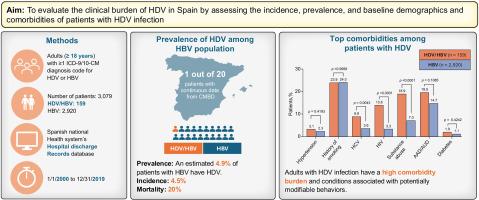Clinical burden of HDV in Spain: Incidence, prevalence, and associated comorbidities
IF 7.5
1区 医学
Q1 GASTROENTEROLOGY & HEPATOLOGY
引用次数: 0
Abstract
Background & Aims
HDV leads to the most severe form of viral hepatitis. It has been estimated to affect 5–13% of people who have chronic HBV worldwide. Evidence of HDV incidence, prevalence, and disease burden in Spain is limited. The purpose of this study is to evaluate the clinical burden of HDV in Spain by assessing the incidence, prevalence, and baseline demographics and comorbidities of patients with HDV infection compared with those with HBV monoinfection.
Methods
Adults (≥18 years) with ≥1 International Classification of Disease-9/10-Clinical Modification diagnosis code for HDV or HBV in the Spanish National Health System’s Hospital Discharge Records Database from January 1, 2000, to December 31, 2019, were identified. HDV prevalence and incidence were calculated. Baseline (duration before index disease) patient characteristics and comorbidities were assessed.
Results
The estimated prevalence of adults with HDV infection among those with HBV was 4.9%, with an incidence of 4.5% over the study period. Adults with HDV infection were significantly younger than those with HBV monoinfection (mean [SD] age 42.7 [14.4] vs. 46.6 [15.9] years, p = 0.0034). Adults with HDV infection reported significantly higher rates of concomitant hepatitis C infection (8.8% vs. 3.6%; p = 0.0043), HIV infection (13.8% vs. 3.3%; p <0.0001), and substance use disorder (18.9% vs. 7.0%; p <0.0001) compared with those with HBV monoinfection.
Conclusions
Adults with HDV infection who attended hospitals in Spain have a high comorbidity burden and conditions associated with potentially modifiable behaviors. Novel treatment strategies are needed to reduce morbidity rates among adults with HDV infection in Spain.
Impacts and implications
Adults with HDV infection who attended hospitals in Spain had a high comorbidity burden and conditions associated with potentially modifiable behaviors (i.e. sexually transmitted diseases and substance abuse). Given the high prevalence of HDV in Spain, these comorbid conditions may contribute to a larger healthcare burden. Chronic HDV infection is also considered the most severe form of viral hepatitis, with a reported mortality rate of 40% in adults with HDV infection. These findings emphasize the importance of enhanced HDV screening in patients with chronic HBV, along with early diagnosis and the prompt initiation of antiviral therapies to manage disease progression and reduce the risk of liver-related morbidity and mortality.

西班牙HDV的临床负担:发病率、流行率和相关合并症
AimsHDV可导致最严重形式的病毒性肝炎。据估计,全世界有5-13%的慢性乙肝病毒感染者受到影响。关于西班牙HDV发病率、流行率和疾病负担的证据有限。本研究的目的是通过评估HDV感染患者与HBV单感染患者的发病率、患病率、基线人口统计学和合并症,来评估西班牙HDV的临床负担。方法选取2000年1月1日至2019年12月31日西班牙国家卫生系统医院出院记录数据库中HDV或HBV临床修改诊断代码≥1的成人(≥18岁)。计算HDV患病率和发病率。基线(指数疾病前的持续时间)评估患者特征和合并症。结果HBV感染者中HDV感染的成人患病率估计为4.9%,研究期间的发病率为4.5%。HDV感染的成年人明显比单HBV感染的成年人年轻(平均[SD]年龄42.7[14.4]比46.6[15.9]岁,p = 0.0034)。与单一HBV感染者相比,HDV感染的成人合并丙型肝炎感染(8.8% vs. 3.6%; p = 0.0043)、HIV感染(13.8% vs. 3.3%; p <0.0001)和物质使用障碍(18.9% vs. 7.0%; p <0.0001)的发生率明显更高。结论在西班牙住院的成人HDV感染患者具有较高的合并症负担和与潜在可改变行为相关的条件。需要新的治疗策略来降低西班牙成人HDV感染的发病率。影响和意义在西班牙医院接受HDV感染的成年人有很高的合并症负担和与潜在可改变的行为(即性传播疾病和药物滥用)相关的条件。鉴于HDV在西班牙的高流行率,这些合并症可能会导致更大的医疗负担。慢性HDV感染也被认为是最严重的病毒性肝炎形式,据报道成人HDV感染的死亡率为40%。这些发现强调了在慢性HBV患者中加强HDV筛查的重要性,以及早期诊断和及时开始抗病毒治疗以控制疾病进展和降低肝脏相关发病率和死亡率的风险。
本文章由计算机程序翻译,如有差异,请以英文原文为准。
求助全文
约1分钟内获得全文
求助全文
来源期刊

JHEP Reports
GASTROENTEROLOGY & HEPATOLOGY-
CiteScore
12.40
自引率
2.40%
发文量
161
审稿时长
36 days
期刊介绍:
JHEP Reports is an open access journal that is affiliated with the European Association for the Study of the Liver (EASL). It serves as a companion journal to the highly respected Journal of Hepatology.
The primary objective of JHEP Reports is to publish original papers and reviews that contribute to the advancement of knowledge in the field of liver diseases. The journal covers a wide range of topics, including basic, translational, and clinical research. It also focuses on global issues in hepatology, with particular emphasis on areas such as clinical trials, novel diagnostics, precision medicine and therapeutics, cancer research, cellular and molecular studies, artificial intelligence, microbiome research, epidemiology, and cutting-edge technologies.
In summary, JHEP Reports is dedicated to promoting scientific discoveries and innovations in liver diseases through the publication of high-quality research papers and reviews covering various aspects of hepatology.
 求助内容:
求助内容: 应助结果提醒方式:
应助结果提醒方式:


